The pork pie with hot water crust is a delicious English classic, and turned keto and gluten-free it just got even better. This handheld pie is traditionally eaten cold (except in Yorkshire), so it’s perfect for lunch boxes, picnics and road trips! Popularly also served in pubs, on Christmas mornings, and… on hunts.
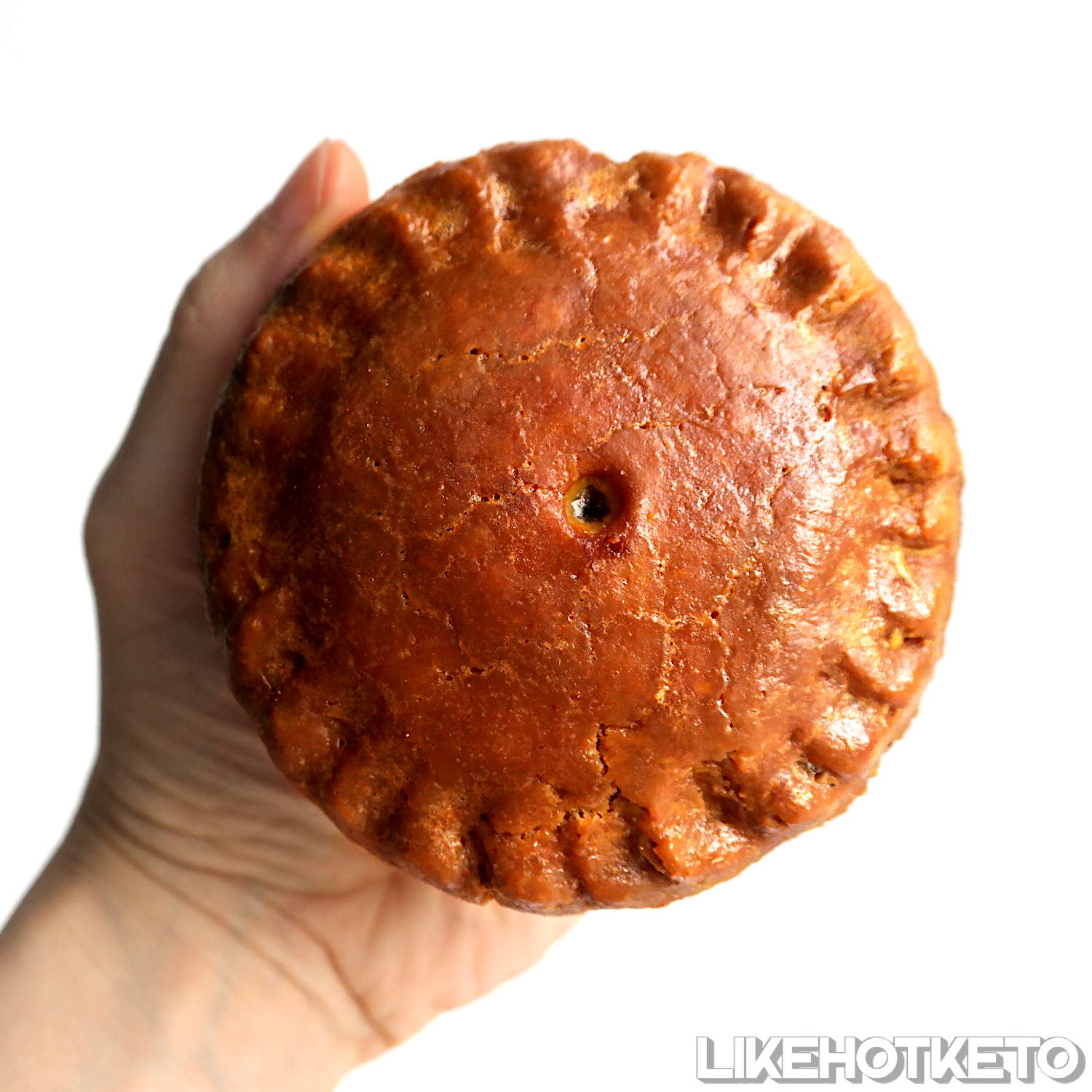
Even if you live in the UK and have easy access to pork pie – as, you can’t walk one block without stumbling into them – finding a low-carb, keto or gluten-free version of one might be a challenge. The classic pork pie crust is made of wheat flour, and, as it’s often the case with sausages, manufacturers might feel the need to stretch the meat filling with rusk, to avoid cutting their own throat.
Not the case with these homemade British keto pork pies! One might seem small, but I assure you it makes for a super nutritious and satisfying meal.
Ingredient notes
Gluten-free hot water crust
Butter and lard: I mixed both for flavor. But you can go full butter or full lard if you prefer. Don’t use oil, you’ll need a hard fat for best texture.
Almond flour + Oat fiber: With a 50-50 combination of these keto and gluten-free flours, these pork pies crust get a flavor and texture quite similar to the original.
Xanthan gum: Really important to keep the dough pliable and makes the shaping and handling of the pork pies much easier!
Eggs: you’ll need eggs for the pastry dough and also to brush on the pork pies and make them shiny!
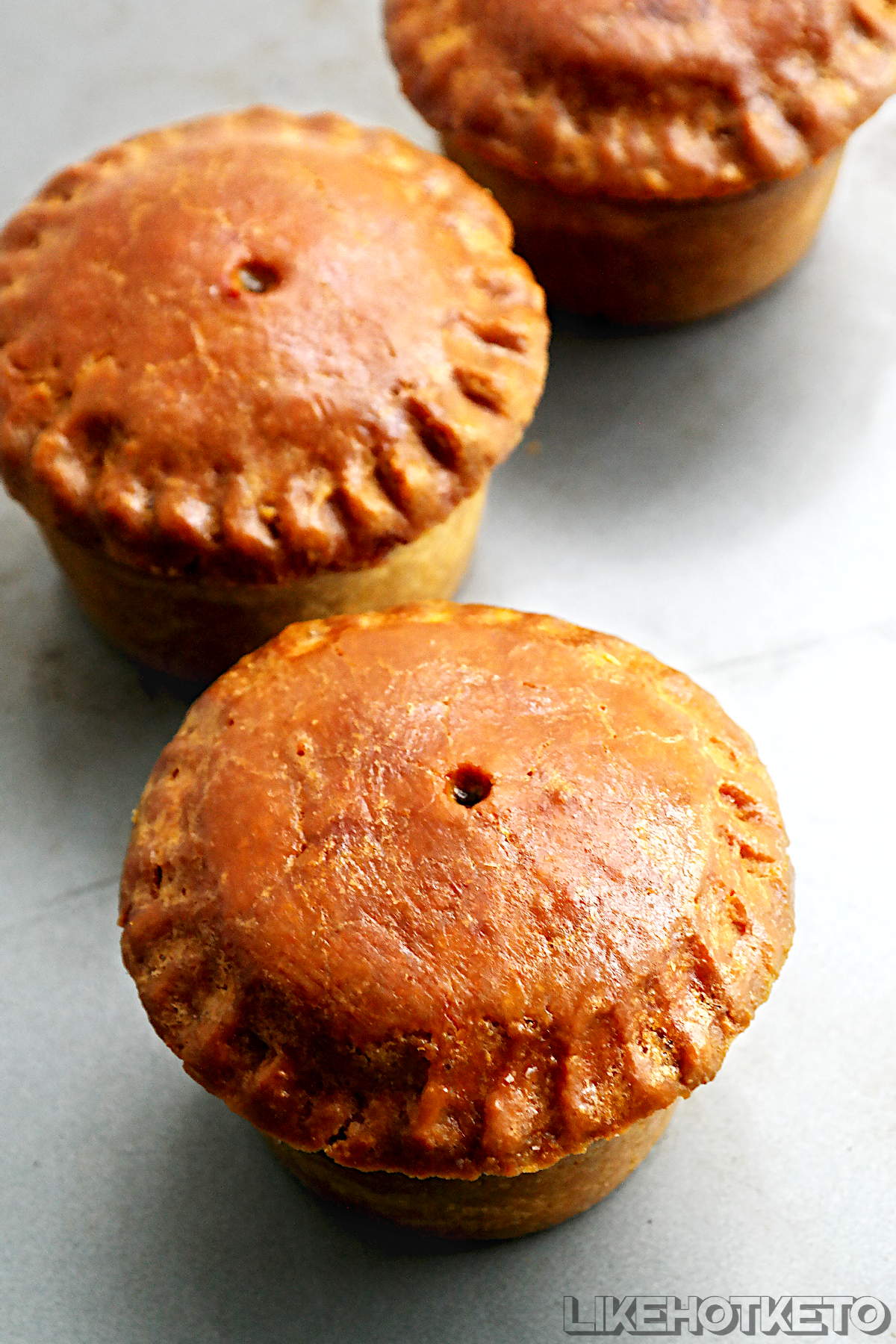
Pork pie filling
Pork: Start with a classic sausage meat ratio, which is 2:1 (65-70% of lean meat to 30-35% fat). You can get in this ballpark by using 2 parts of pork tenderloin to 1 part of pork belly, or going full on pork shoulder (butt), which is a cut naturally close to the ideal sausage ratio.
I used the tenderloin and belly mix, because in Dubai all pork comes frozen in packs and there’s not much choice.
As for preparation, you can, arguably, improve the texture of the meat filling by chopping the pork by hand into veeery small pieces… I have no patience for that, so I minced everything. You could use half minced, half chopped pork for a more interesting keto pork pie texture.
Spices: The classic pork pie flavor is easy to achieve with few spices, you’ll need black and red pepper, sage and (or) thyme, in small amounts, and mace.
Mace is traditionally used for pork pies, but you could substitute for fresh ground nutmeg, as it’s generally easier to find, although not nearly as aromatic.
I’m not sure if the extra work is worth it, though. I’ll say, even with the whole pork minced this is by far the best pork pie I’ve had. Maybe because I’ve never really had a fancy Melton Mowbray pie, just “pies with personality”. Not something I would leave for the Hogfather. Anyhoo, nothing beats homemade.
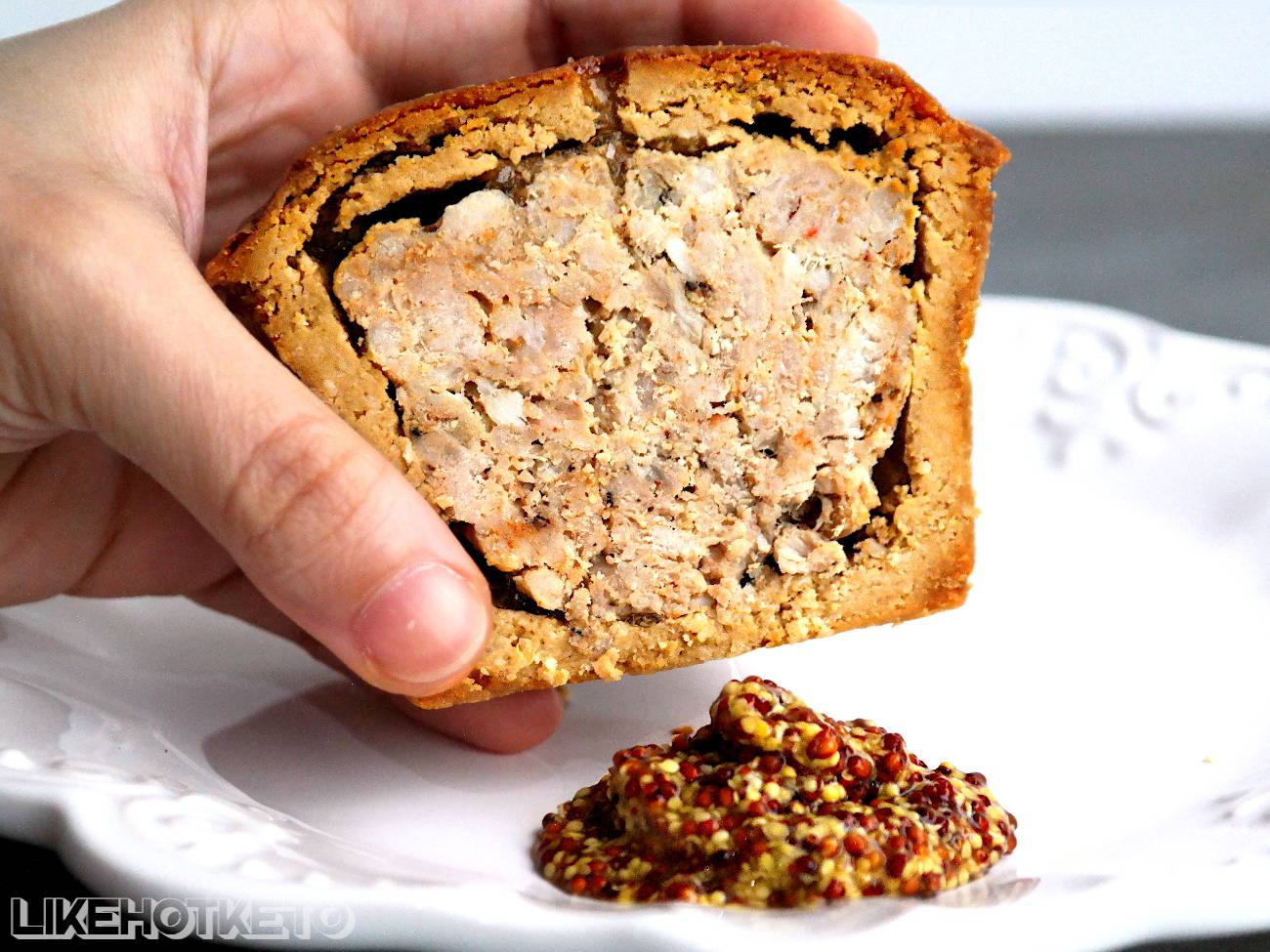
How to make the filling
Get your mix of pork tenderloin and pork belly, or full pork shoulder. Remember, the important thing is to reach the ideal sausage ratio of 2:1 lean meat to fat.
Cut the whole amount of meat finely by hand (just kidding… well maybe some will), or mince it. Use a coarse grind, for a chunkier texture. If you don’t have a mincer, just ask your butcher to mince the meat for you. You can also use a food processor.
Then, just mix in the salt, pepper and spices, cover and refrigerate until it’s time to fill in the pies.
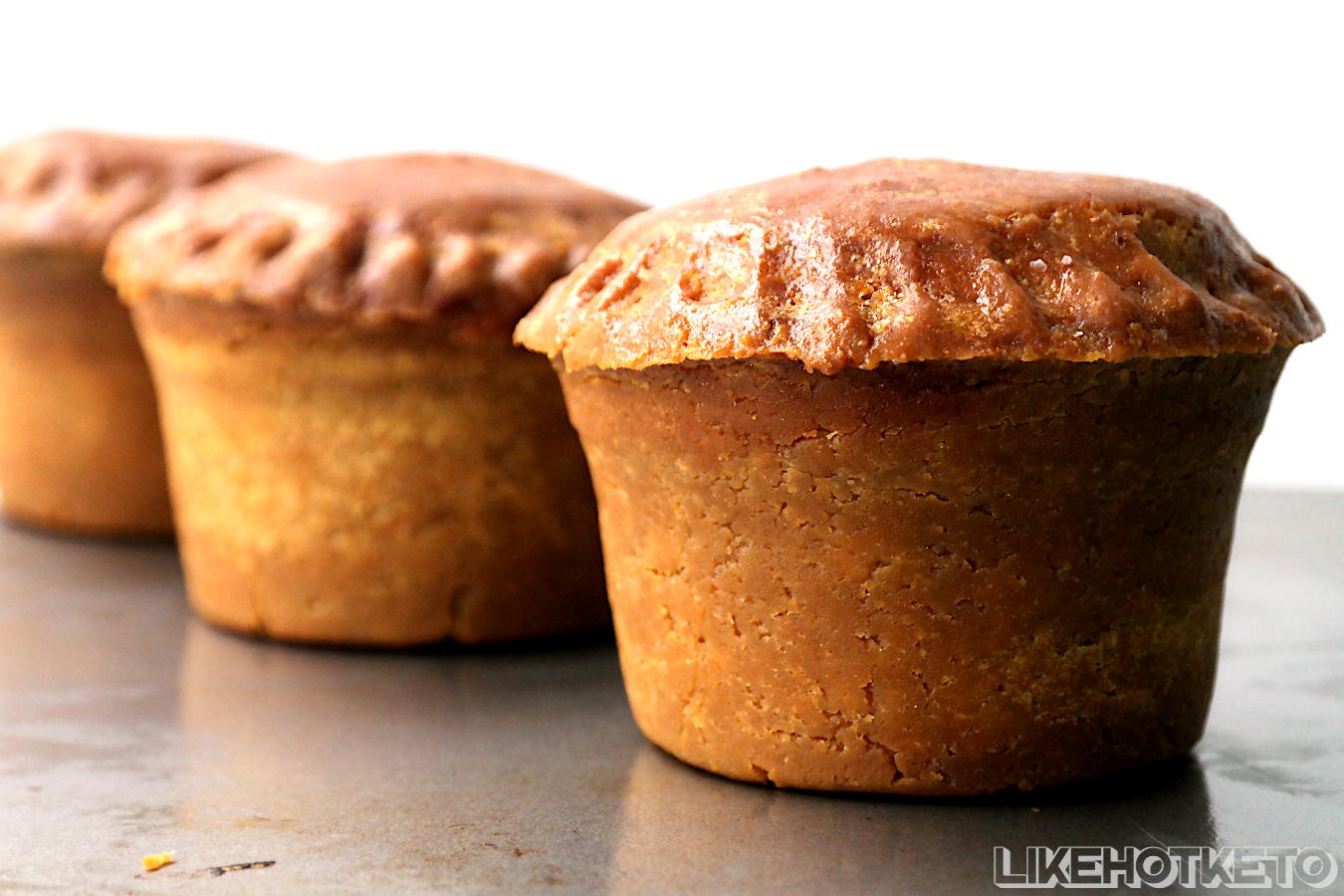
How to make hot water crust pastry
Interesting fact: did you know that pork pies used to be keto and gluten-free? In a way. Because, in medieval times when they were created, the dough wasn’t actually eaten. The hot water crust and pork jelly served only for the purpose of preserving the meat inside, before refrigerators were invented. But throwing dough away and eating only the fillings sounds a bit crazy nowadays… so here’s how to make the keto pork pie crust:
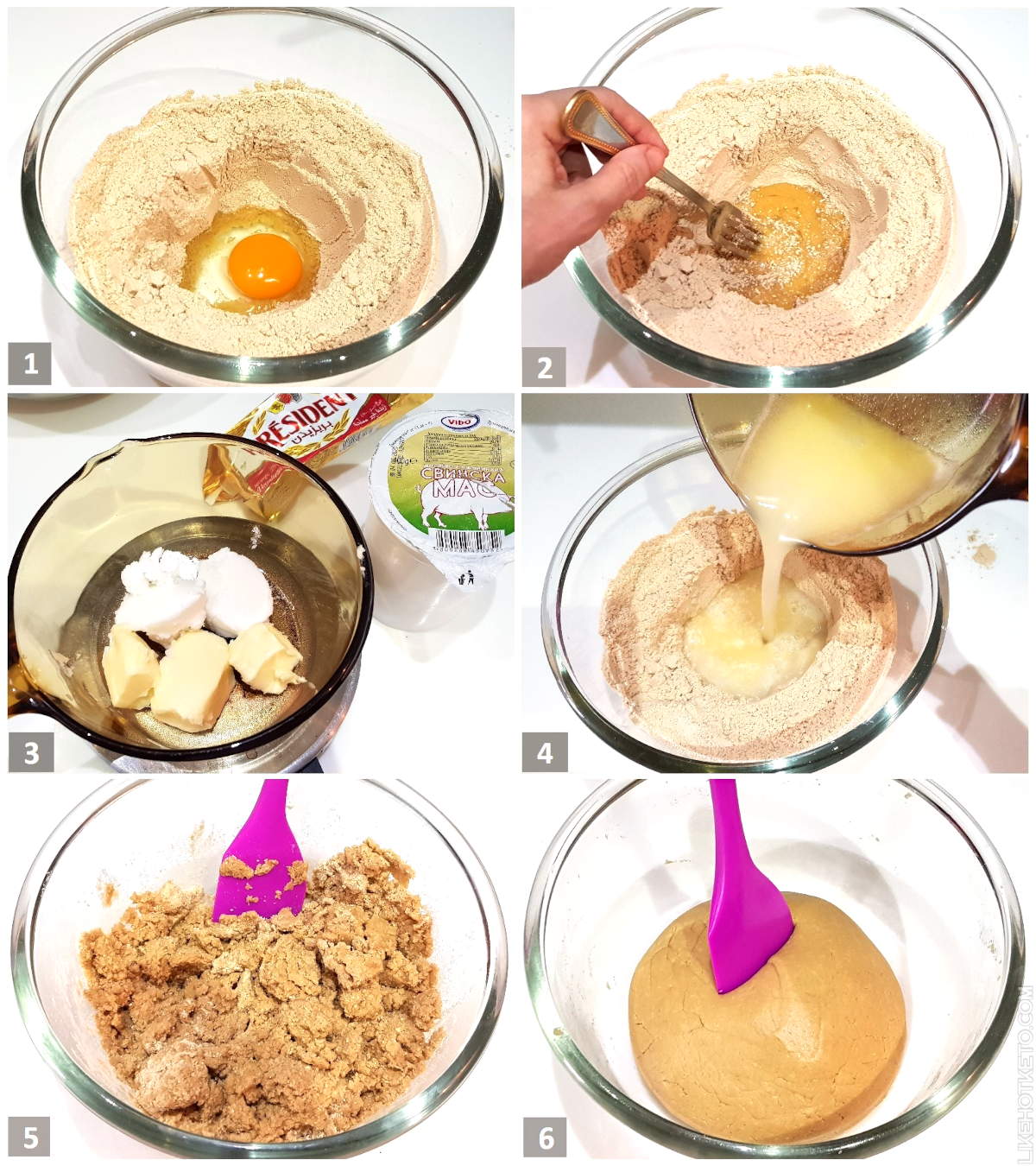
In a large bowl, mix together the dry ingredients for the pork pie crust – almond flour, oat fiber, xanthan gum and salt. Make a whole in the middle, drop one egg inside (1-2) and mix it up as best as you can.
In a pan, add the butter, lard (3) and water and heat it over medium heat to melt the fats (You could go full butter or full lard, I mix them for flavor – I love both and can’t decide).
Raise the heat, and as soon as it starts boiling, pour the whole thing (4) into the middle of the flour mixture (careful not to splash and burn yourself!). Immediately stir everything with a large silicone spatula or wooden spoon (5). Continue mixing until a homogenous dough is formed (6). The hot water will cook the flours, thus making the traditional pork pie hot water pastry.
Now wait until the dough is just cool enough to handle, it shouldn’t take long.
How to assemble the pork pies
Pork pies can be either hand-raised, which is a free form style of pork pie that looks quite rustic, or shaped inside molds. I tried to hand raise the hot water crust, but it was a sticky mess. I don’t have a proper wooden pie raising dolly, so I tried to shape the dough around a tumbler glass, and it just got stuck. So let’s go with the molded method for these keto pork pies:
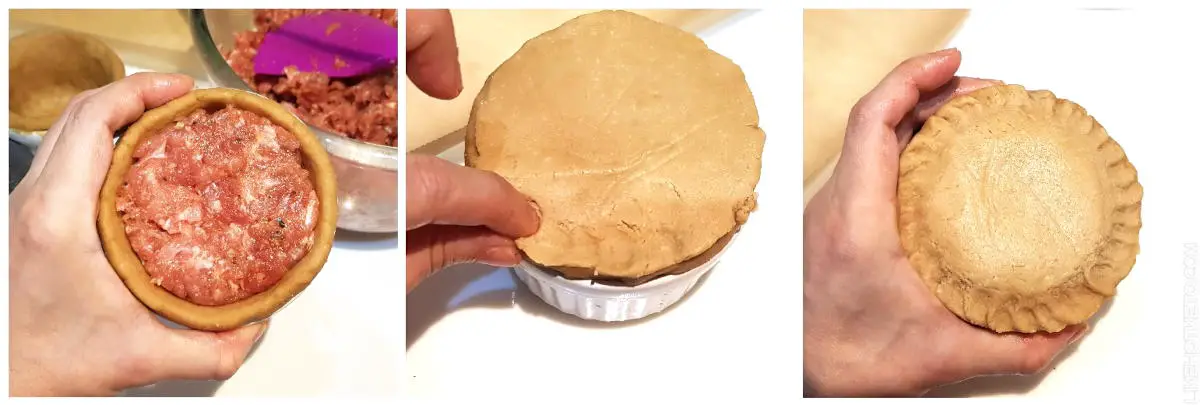
You’ll need 6 ramekins, or similarly sized molds. Mine are 4 OZ size. It shouldn’t be a problem to use a large muffin tray.
Grease each of the pork pie molds. You need to work while the dough is still warm, so it remains pliable. Separate it into 6 large balls (around 120 grams), and 6 small ones (about 35 grams).
Take a bigger ball of keto pie dough, and press it into the mold, then push it into the sides and up to the edges. Make sure there are no holes, or the liquid jellied stock that will be poured in later will leak.
Divide the meat into 6 portions (I make balls) and put each inside a dough lined mold. There should be some space left on the top, to accommodate the lid.
Beat one egg, and brush some around the edges of the dough, to help glue the lid in place. Get the smaller ball of dough, press it between your hands to form a thin lid and place on top, and gently pinch and press all around it, sticking the top and bottom of the pie together.
Brush the keto pie tops with a thick layer of beaten egg. Make a hole on the top of the pie, for the steam to escape during cooking, and to fill with pork pie jelly after.
Baking keto pork pies
Pre-heat the oven to 200 °C (390 °F). Bake the pies for one hour, then take them from the oven for a second round of egg wash. Turn the temperature down to 175°C (350°F) and bake for another half an hour. Remove the keto pork pies from the oven and allow them to cool inside the molds.
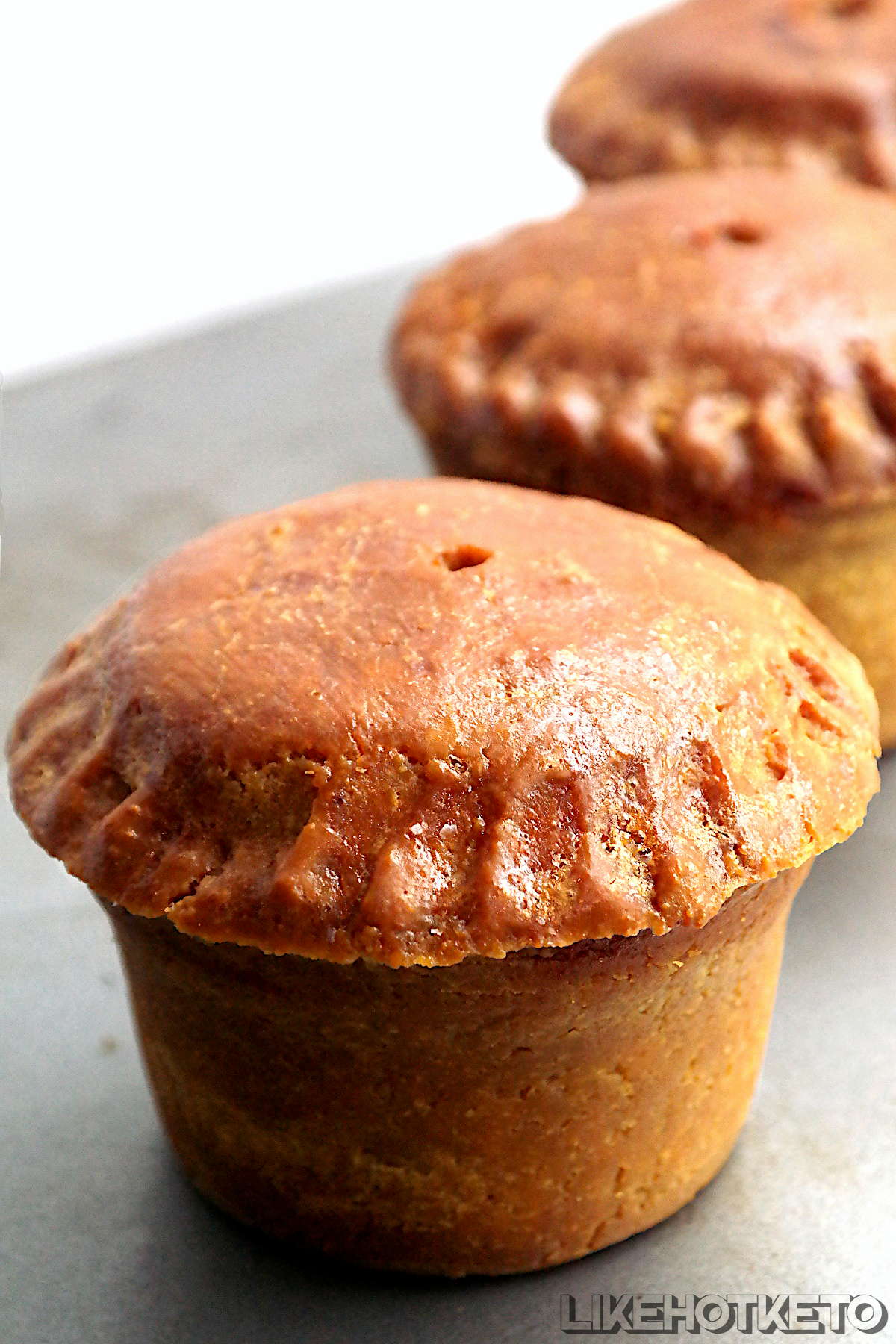
How to prepare pork pie jelly
During cooking, the meat filling of the British pork pie shrinks, creating a gap between the meat and the surrounding pastry. To fill in that gap, traditionally a collagen rich pork stock made by boiling pork trotters or pure hot fat are poured inside the pie. This forms a barrier against the air, which not only preserves the meat but also helps keep it moist and flavorful.
A simpler alternative to the trotter stock, and more palatable than pure fat, is made by mixing unflavored gelatin with hot chicken or beef stock, that are much easier to find ready made.
Get the chosen stock hot (but not boiling), and mix in the gelatin until fully dissolved. Wait for it to cool down until it’s just warm.
Pour the liquid gelatin stock slowly inside the keto pork pies through the vent hole on the top, until it is full. Allow some time to soak (so it doesn’t overflow), the put in some more. Using a small funnel, like the sort to fill in hip flasks, is going to be very helpful. Or, you can try using a jar with a every precise sprout, which might make a mess but will get the job done.
Take the pies full of stock to the fridge for a few hours at least for the jelly to firm up.
How to serve pork pies
Your keto and gluten-free classic British pork pies are ready to be savored! Ideally serve them at room temperature, to be eaten by hand, or along side some mustard, tomato chutney, pickles or a light leafy salad.
British pork pies are also a great addition to a charcuterie board: cut a pork pie in slices for a beautiful display!
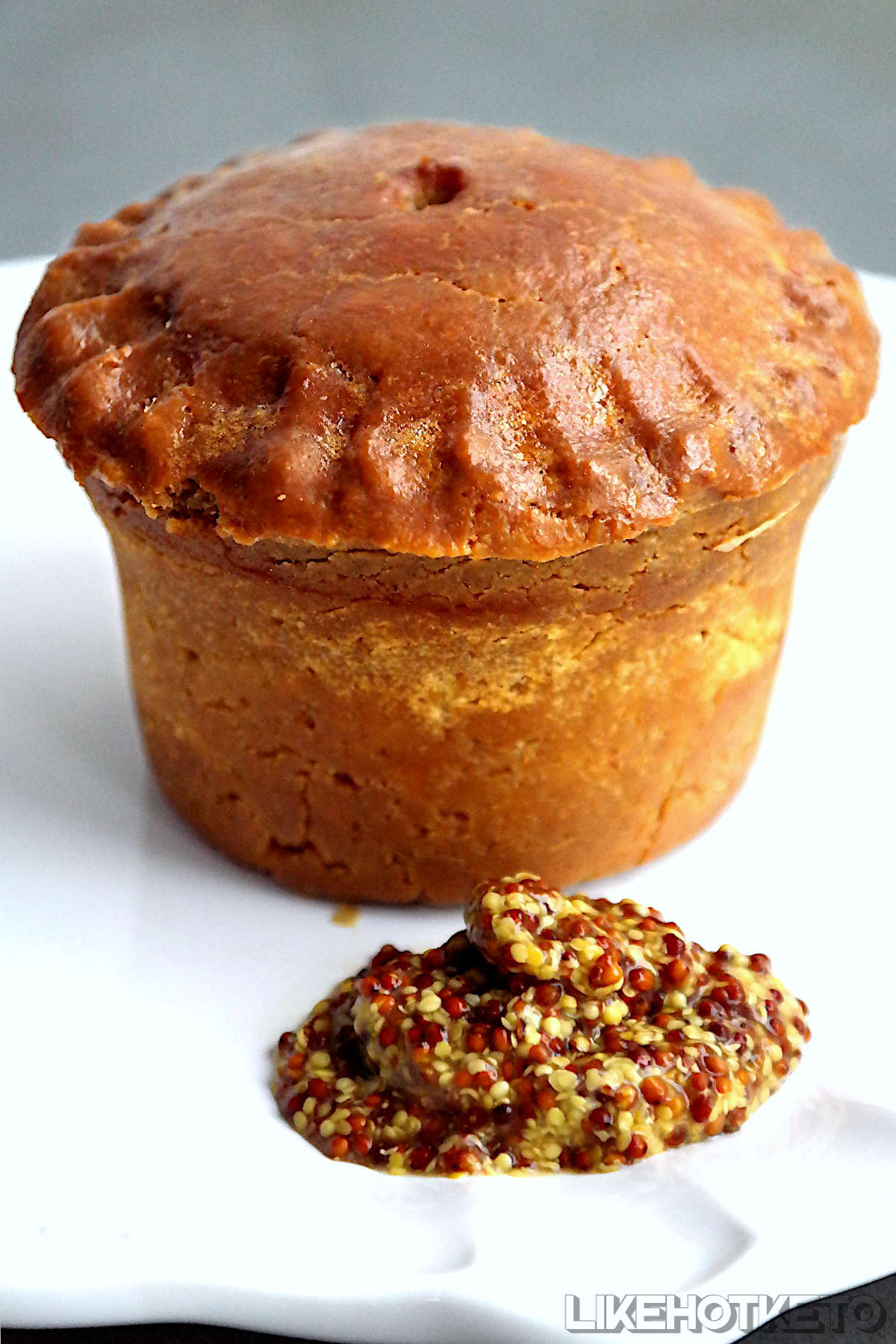
Storage and freezing
Making these gluten-free pork pies is undoubtedly a lot of work. It’s good to know that they freeze well – so much so that they are usually sold in the frozen section of the groceries. It’s great to have a freezer packed with keto pork pies for a quick meal or snack!
If consuming the pork pies within 3-4 days, you can keep them in the fridge. Keep them inside an air tight container, or in plastic bags. Remove from the fridge about one hour before serving, for best flavor – no need to heat them up!
To freeze pork pies, after they are fully baked, filled with jelly and cooled down, wrap them individually in parchment paper, them put them in sealable freezer bags. They will last for many months. When you feel like having a pork pie, remove from the freezer and put in the fridge one day in advance.
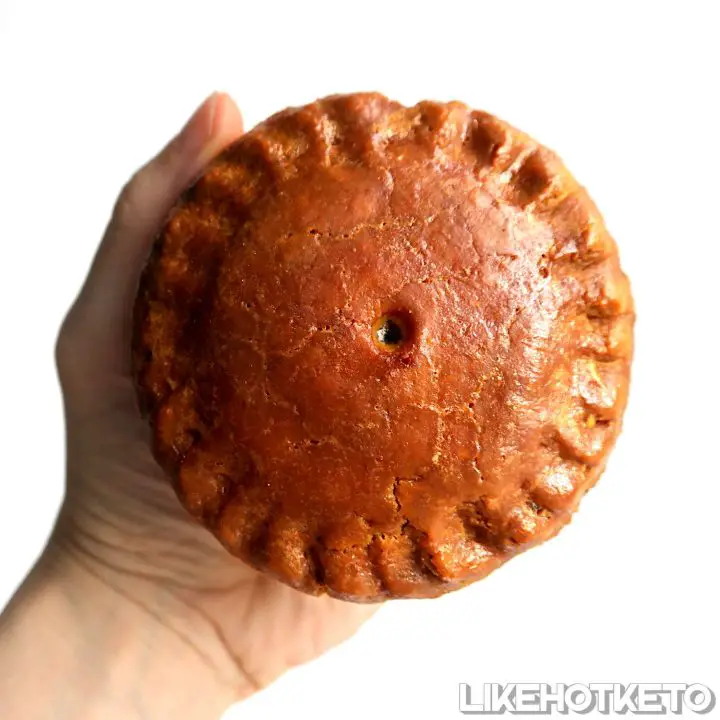
Classic British Pork Pie
These keto and gluten-free British pork pies are the most wonderful and versatile hand held food, perfect for road trips, camping and picnics! They are also perfect sliced on a charcuterie board, alongside your favorite chutney or mustard.
Ingredients
Hot water crust pastry
- 60 grams (~1/4 cup) butter
- 60 grams (~1/4 cup) lard
- 200 grams (3/4 cup + 1 tablespoon) water
- 200 grams (~2 cups) oat fiber
- 200 grams (~2 cups) almond flour
- 1 1/2 teaspoon xanthan gum
- 1 teaspoon fine salt
- 1 egg + 1 beaten egg for brushing
Pork pie filling
- 900 grams (~2 pounds) pork shoulder (or 2/3 pork tenderloin and 1/3 pork belly)
- 1 1/2 teaspoon fine salt
- 1 teaspoon ground black pepper
- 1/2 teaspoon red pepper powder
- 1/4 teaspoon ground mace or nutmeg
- 1 teaspoon chopped fresh sage and/or thyme (optional)
- 125 grams (1/2 cup) beef/bone or chicken stock
- 15 grams (~1 1/2 tablespoon) unflavored gelatin powder
Instructions
- Mince the meat by cutting it very finely by hand, or using a meat grinder with the coarse blade, or using a food processor.
- Add the salt, pepper and spices, and mix well. Separate the meat into 6 portions of the same size.
- In a large bowl, mix together the dry ingredients – almond flour, oat fiber, xanthan gum and salt.
- Make a whole in the middle, drop one egg inside and mix it up as best as you can.
- In a pan, add the butter, lard and water and heat it over medium heat until the fats are fully melted.
- Raise the heat, and as soon as it starts boiling, carefully pour all the liquid, at once, in the middle of the flour mixture.
- Immediately stir everything with a large silicone spatula or wooden spoon. Continue mixing until a homogenous dough is formed.
- Grease each of the pork pie molds/pans.
- When the dough is just cool enough to handle, separate it into 6 large balls (around 120 grams each), and 6 small ones (about 35 grams each).
- Press one of the larger balls of hot water dough into the mold, pushing it the sides and up to the edges. Make sure there are no holes.
- Put one portion of meat inside each dough lined mold. Leave some space on the top, to attach the lids.
- Stretch the smaller balls of dough into a disc about the size of the top of the pies, to form the lids.
- Beat one egg, and brush some around the edges of the pie, to help glue the lids in place.
- Place the disc of dough on top of the pie, and gently pinch and press all around it, sticking the top and bottom together.
- Brush the keto pie tops with a thick layer of beaten egg, and make a hole in the center of the pies.
- Pre-heat the oven to 200 °C (390 °F). Bake the pies for one hour, then take them from the oven for a second round of egg wash.
- Turn the temperature down to 175°C (350°F) and bake for another half an hour.
- Remove the keto pork pies from the oven and allow them to cool inside the molds.
- Get the chosen stock hot (but not boiling), and mix in the gelatin until fully dissolved. Wait for it to cool down until it's just warm.
- Pour the liquid gelatin stock slowly inside the keto pork pies through the hole on the top, until it is full. Allow a moment to soak (so it doesn't overflow), the put in some more.
- Take the pies full of stock to the fridge for a few hours at least for the jelly to firm up.
Notes
Nutrition information shows recipe made with pork shoulder. Recalculate if using different cuts.
Recommended Products
As an Amazon Associate and member of other affiliate programs, I earn from qualifying purchases.
Nutrition Information:
Yield: 6 Serving Size: 1Amount Per Serving: Calories: 603Total Fat: 46.3gNet Carbohydrates: 3gProtein: 40.4g
Nutrition information is provided as a guideline only. Different brands of ingredients may have different nutrition facts. If tracking macros, remake the calculations using the nutrition facts from the labels of the ingredients you selected. Net carbs calculated exclude carbs from insoluble fiber and sugar alcohols.
Copyright Pris Frank for LikeHotKeto. Please DO NOT SCREENSHOT OR COPY/PASTE recipes to social media or websites. We’d LOVE for you to share a link to this recipe instead 🙂 Try the easy sharing buttons below!





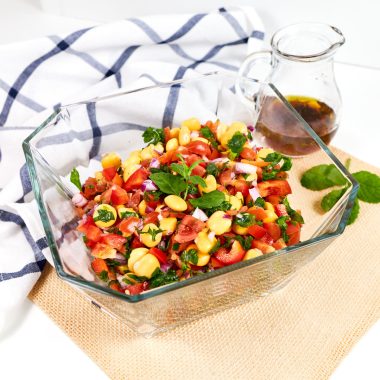
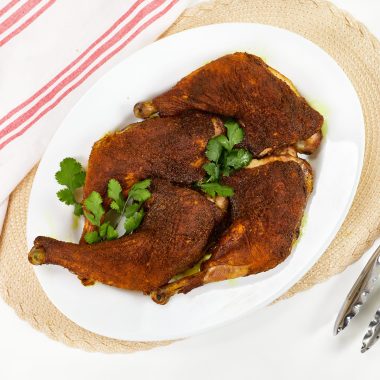


That’s a shame Phil, I’d like to try and help you troubleshoot this so you’ll hopefully get a better result if you try again. About the color, it’s fine being different as oat fiber varies in color a lot (from nearly white to brownish) depending on brands. Not sure why. When you say you used 100% oat fiber, do you mean that you used just oat fiber for the recipe (no almond flour)?
Made this yesterday but was no way near the colour of yours , and very very crumbly when trying to mould even though I added more water , followed all the quantities exactly , used 100 % oat fibre -weird stuff !
May try again on Friday to make it
Hi Phil! Oat fiber is the only low-carb/keto oat product, it’s pure insoluble fiber made from the oat’s husks. Oat fiber will give a nice crumbly texture to keto baked goods without adding net carbs. There are other oat products like oat flour, oat bran, oat meal, oat groats – these can be easy to mistake for oat fiber, so just make sure that the ingredients on the package read “100% OAT FIBER”. There are a few different brands of oat fiber (Anthony’s, NuNaturals, Lifesource, etc.) unfortunately not very easy to find in general grocery stores. You can get it from Amazon or specialized health food stores.
Hi
Can I just ask what sort of oat fiber you use – I’ve seen a few different types
Thanks
Hi Paul! You can use either one, depends what you have/how spicy you prefer. Red pepper powder is just cayenne pepper (which is a chili pepper), chili powder can have cayenne too but is also composed of less hot peppers, and is usually mixed with other spices. The pure red pepper powder (cayenne) is hotter than chili powder.
The red pepper powder in this recipe….is this essentially chilli powder ?
Thanks Paul